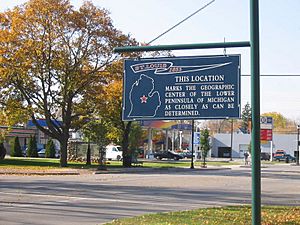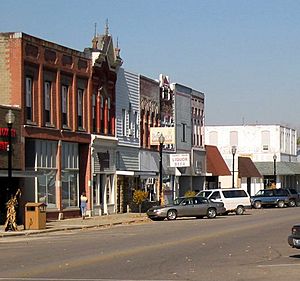St. Louis, Michigan facts for kids
Quick facts for kids
St. Louis, Michigan
|
|
|---|---|
| Motto(s):
Middle of the Mitten
|
|

Location of St. Louis, Michigan
|
|
| Country | United States |
| State | Michigan |
| County | Gratiot |
| Area | |
| • Total | 3.50 sq mi (9.06 km2) |
| • Land | 3.31 sq mi (8.59 km2) |
| • Water | 0.18 sq mi (0.47 km2) |
| Elevation | 732 ft (223 m) |
| Population
(2020)
|
|
| • Total | 7,010 |
| • Density | 2,114.63/sq mi (816.52/km2) |
| Time zone | UTC-5 (Eastern (EST)) |
| • Summer (DST) | UTC-4 (EDT) |
| ZIP Code |
48880
|
| Area code(s) | 989 |
| FIPS code | 26-71000 |
| GNIS feature ID | 0636831 |
St. Louis is a friendly city located in Gratiot County, in the state of Michigan. It's a place with interesting history and a special spot in the state. In 2010, about 7,482 people lived here.
Contents
Geography of St. Louis
St. Louis covers a total area of about 3.53 square miles (9.14 square kilometers). Most of this area is land, with a small part being water.
The Middle of the Mitten
St. Louis is known for being very close to the exact center of Michigan's lower peninsula. This part of Michigan looks like a mitten! In the 1950s, a local newspaper owner and his wife, Clarence and Odessa Smazel, worked to make this official.
Now, a sign in Clapp Park on Highway M-46 proudly shows St. Louis as the "Middle of the Mitten." It's a fun fact about the city!
History of St. Louis
Long before European settlers arrived, Indigenous people lived in this area for thousands of years. The French were among the first Europeans to explore Michigan. They traded furs with the local First Nations and Native American groups.
By the 1700s, the Ojibwe tribe was the main group in what is now Michigan. After a big war called the Seven Years' War, France gave its land to the English. Later, after the American Revolutionary War, the land became part of the new United States.
Early Settlements and Missions
European-American settlers didn't arrive in large numbers until the mid-1800s. In 1848, missionaries started the Bethany Lutheran Mission. This mission was created to help the local American Indians, who were mostly Ojibwe people.
In 1853, Joseph W. Clapp followed a Native American path to the mission. He built the first house in what would become St. Louis. Today, over 150 years later, the Mission building still stands near the Main Street Bridge over the Pine River.
Mineral Springs and Health Spas
In the late 1800s, people discovered special mineral springs in St. Louis. The water from these springs was believed to have health benefits. It was even said to make steel magnetic!
Many famous guests visited, hoping the water would help them. These included detective Allan Pinkerton and Civil War general "Fighting Joe" Hooker. The Park Hotel became a famous health spa and was also known for its delicious duck dinners.
Chemical Plant and Environmental Cleanup
St. Louis was once home to the Michigan Chemical Corporation plant. This plant helped make and sell DDT, a widely used product. Later, the plant was bought by Velsicol Chemical Corporation.
In the 1970s, a serious mistake happened at the plant. Cattle feed was accidentally mixed with PBB, a chemical used to stop fires. This contaminated feed was sent to farms all over Michigan and the Midwest. The mistake happened because of several problems at once.
For many years, work has been done to clean up the Pine River. The river runs next to where the plant used to be, and it was affected by the contamination. Even though the plant was taken apart years ago, the land is still empty today.
To create new jobs, St. Louis invited the State of Michigan to build a prison here. The Pine River Correctional Facility is a minimum-security prison located between Union and Croswell Roads.
Population and People
| Historical population | |||
|---|---|---|---|
| Census | Pop. | %± | |
| 1870 | 888 | — | |
| 1880 | 1,975 | 122.4% | |
| 1890 | 2,246 | 13.7% | |
| 1900 | 1,989 | −11.4% | |
| 1910 | 1,940 | −2.5% | |
| 1920 | 3,036 | 56.5% | |
| 1930 | 2,494 | −17.9% | |
| 1940 | 3,039 | 21.9% | |
| 1950 | 3,347 | 10.1% | |
| 1960 | 3,808 | 13.8% | |
| 1970 | 4,101 | 7.7% | |
| 1980 | 4,107 | 0.1% | |
| 1990 | 3,828 | −6.8% | |
| 2000 | 4,494 | 17.4% | |
| 2010 | 7,482 | 66.5% | |
| 2020 | 7,010 | −6.3% | |
| U.S. Decennial Census | |||
2010 Census Information
In 2010, the city had 7,482 people living in it. This number included about 3,823 people living in institutions, mostly at the Pine River Correctional Facility. There were 1,491 households and 937 families.
The population density was about 2,240 people per square mile (865 per square kilometer). Most residents (67.7%) were White, and 29.1% were African American. About 5.7% of the population was Hispanic or Latino.
About 34.6% of households had children under 18. The average household had 2.45 people, and the average family had 3.04 people. The median age in the city was 36.1 years old.
Getting Around St. Louis
Here are some of the main roads that help people travel in and out of St. Louis:
 US 127
US 127


 Bus. US 127
Bus. US 127 M-46
M-46
Famous People from St. Louis
Many interesting people have connections to St. Louis:
- Archibald Bard Darragh (1840–1927) was a Member of Congress from 1901 to 1909. He lived in St. Louis for many years, was a banker, and was elected mayor in 1893.
- Edward Hartwick (1871–1918) was a United States Army officer and businessman. Michigan's Hartwick Pines State Park is named after him. He was born and grew up here.
- Jim Northrup (1939–2011) was a baseball player for the Detroit Tigers. He played a big part in their 1968 World Championship team. He was born nearby but graduated from high school in St. Louis.
- Bradbury Robinson (1884–1949) is famous for throwing the first forward pass in football history! He lived in St. Louis from 1926 until his death. Dr. Robinson started the Robinson Clinic in 1935 and was elected mayor twice.
- Lester "Tug" Wilson (1885–1969) played baseball briefly for the Boston Red Sox in 1911. He was born in St. Louis.
See also
 In Spanish: St. Louis (Míchigan) para niños
In Spanish: St. Louis (Míchigan) para niños



